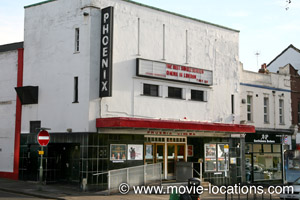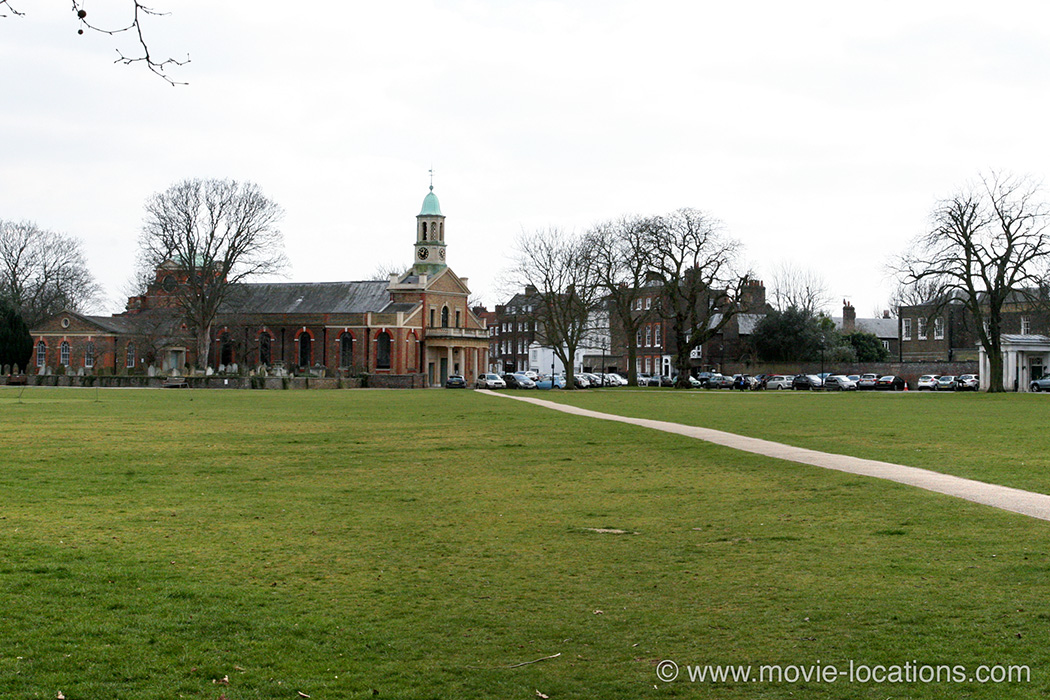The End Of The Affair| 1999


- Locations |
- London;
- East Sussex
- DIRECTOR |
- Neil Jordan
Neil Jordan manages to bring an austere poetry to the exhausted shabbiness of the Forties in this adaptation of the Graham Greene novel, saturated with the author’s trademark Catholicism, sex and guilt.

Director Jordan revisits a couple of locations from his previous films, including the glittering art deco bar of the Sheraton Park Lane Hotel, Piccadilly W1, which stands in for the ‘Café Royal’. It was formerly seen in Mona Lisa, as well as appearing as as a 'New York' hotel in romcom Made Of Honor, in The Golden Compass, Guy Ritchie’s Revolver, and you can even see the hotel’s luxurious toilets in Paul McGuigan’s Gangster No.1

Almost as gleaming and impressive is the carved-wood and etched-glass bar where Maurice Bendrix (Ralph Fiennes) receives evidence of supposed ‘intimacy’ by his ex-lover, Sarah Miles (Julianne Moore), from private detective Parkis (Ian Hart). It’s the Prince Alfred, 5a Formosa Street, Maida Vale, seen also in Michael Radford’s artsy B Monkey, Chen Kaige’s misfired erotic thriller Killing Me Softly, and in the broad 1991 comedy King Ralph, with John Goodman inheriting the British throne.
The bar retains its original ‘snob screens’ from an earlier age, when patrons were divided up by class and gender to patronise separate, smaller rooms. Although each has its own outdoor entrance, you can access the various bars from inside by what are essentially glorified ‘cat flaps’, intended for the use of bar staff and cleaners. You’ll struggle to retain your dignity, but I’ll bet you won’t be able to resist trying.

The devout but conflicted Sarah remonstrates with God in the Priory Church of St Bartholomew the Great, West Smithfield, while Parkis and his son spy on her. London's oldest surviving church, St Bartholomew’s, which gives its name to the famous hospital alongside, was founded in 1123 as an Augustinian Priory, and has been in continuous use since at least 1143.
The church has been extremely film-friendly, so you might recognise it from Nineties smash rom-com Four Weddings And A Funeral, Guy Ritchie’s Sherlock Holmes, Oscar-winner Shakespeare In Love, Shekhar Kapur’s epic Elizabeth: The Golden Age and Kevin Costner romp Robin Hood, Prince Of Thieves.

North, near Angel in Islington, stands the handsome Georgian Myddelton Square. On the west side, at Inglebert Street, 63-65 Myddelton Square is the home of Father Smythe (Jason Isaacs), Sarah’s priestly confidant. The normally elegant terraces, dating from 1827, are made to look weedy and grubby, but don’t be fooled. This is a highly desirable address.

Across the street is the Anglican Gothic St Mark’s Church, is Smythe’s church where Sarah finds the investigator’s boy asleep in the doorway.

The tube station staircase, seen as Sarah hurries to meet Bendrix at the restaurant, is the largely unmodernised Maida Vale station on the Bakerloo Line (you can see its exterior masquerading as the fictitious ‘Westbourne Oak Station’ in the 2014 film of Paddington).

Another location previously used by Neil Jordan is the old movie palace which Sarah flees pursued by Bendrix. It’s the Phoenix Cinema, 52 High Road, East Finchley, the UK’s oldest purpose-built cinema in continuous use, which became the ‘American’ picture house visited by Louis (Brad Pitt) in Interview With The Vampire.
‘Clapham Common’ is largely Battersea Park, though Bendrix’s house, supposedly on the Common, is Abingdon House, 61 Kew Green, near to the famous Royal Botanic Gardens. The corrugated iron alongside masks, not a bombed site, but Kew Gardens’ herbarium building. In fact, you can catch a glimpse of one of the gardens’ entrances in the background as Bendrix runs across the green to stop Sarah’s cab.

Across Kew Green, the church, on which the V1s (Nazi Germany’s terrifying flying bombs) fall, is the Parish Church of St Anne.
Maurice and Sarah spend a weekend at the East Sussex seaside resort of Brighton, appearing as seedy as it does in Greene’s Brighton Rock. The pair inevitably pay a visit to the famous mock-Oriental Royal Pavilion.

In the 1780s, the South Coast fishing town of Brighton was being developed into a retreat for the rich and famous when George, Prince of Wales, the flamboyantly fun-loving son of King George III, had his modest lodging house expanded into a villa, which became known as the Marine Pavilion.
If you know your British history (or you've seen Nicholas Hytner’s film of Alan Bennett's The Madness Of King George), you'll know that George III's mental state meant he became incapable of acting as monarch, and his son became Prince Regent. Within a few years, George had commissioned John Nash to transform this Pavilion into the very un-British, wildly exotic palace, complete with Chinese furniture and hand-painted wallpaper.
The arrival of George IV (as he became) gave rise to the building of the town’s handsome seafront squares and crescents.
On screen, the Pavilion becomes a royal palace in the 1995 Ian McKellen film of Richard III, and its capacious kitchens crop up in Barbra Streisand musical On A Clear Day You Can See Forever.

The church in which Sarah unburdens herself as peace breaks out at the end of WWII is St Mary Magdalene, Woodchester Square. The same church is used for the memorial service in The Constant Gardener, which also stars Ralph Fiennes. Its exterior can be seen in 1949 British classic The Blue Lamp and is also glimpsed in Joseph Losey’s bizarre Secret Ceremony.
Sarah’s funeral is held among the flamboyant Victorian monuments of Kensal Green Cemetery, Harrow Road, where Bendrix is told of the miraculous disappearance of the investigator’s boy’s birthmark. You can see more of this Gothic extravaganza in the gloriously tasteless Vincent Price horror comedy Theatre Of Blood.





